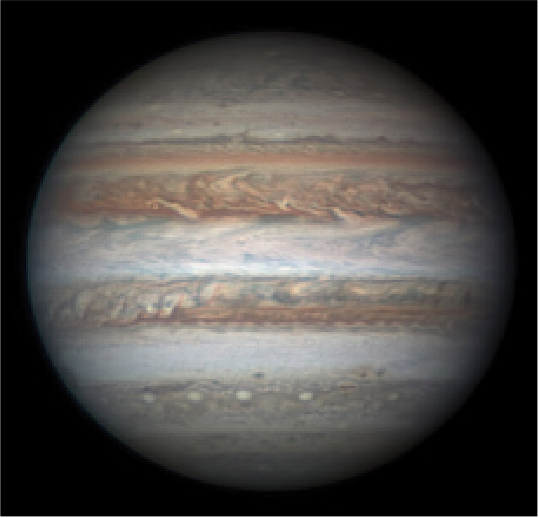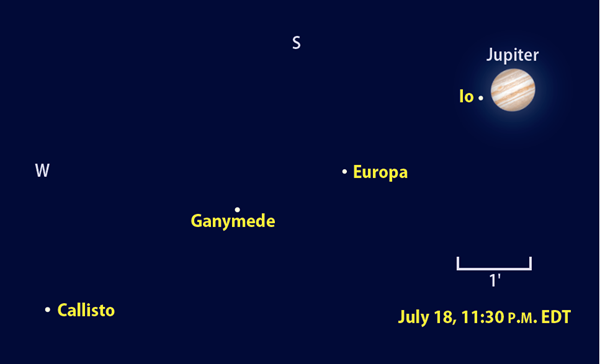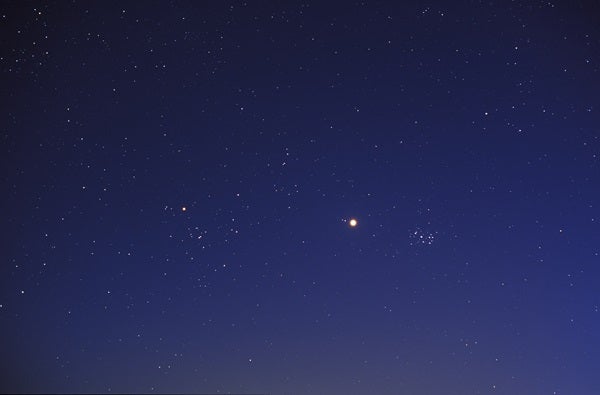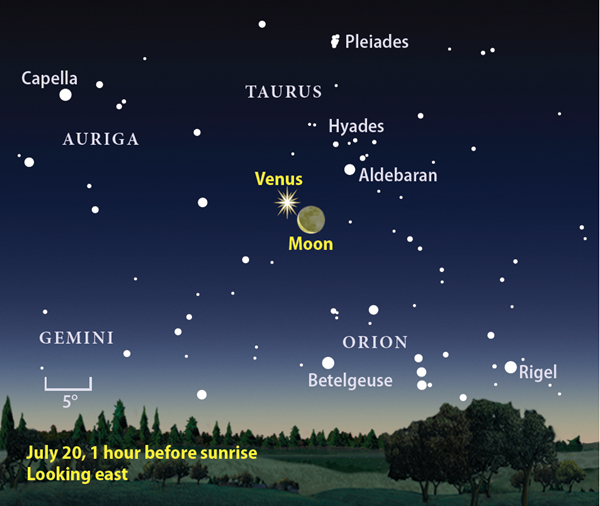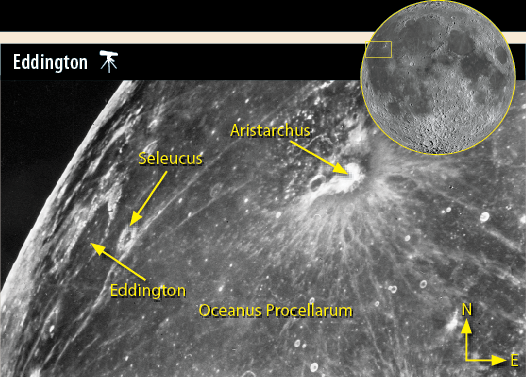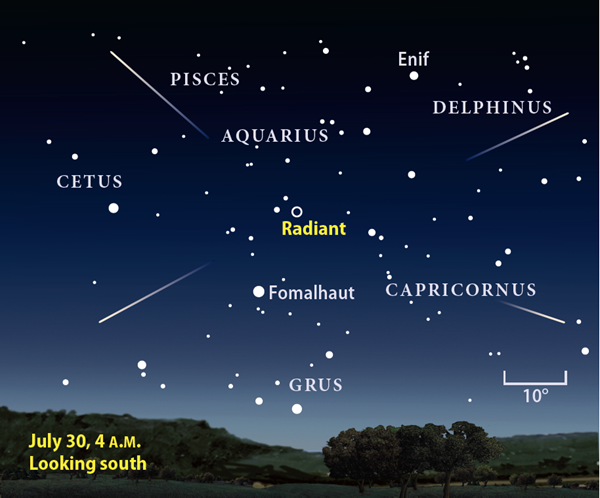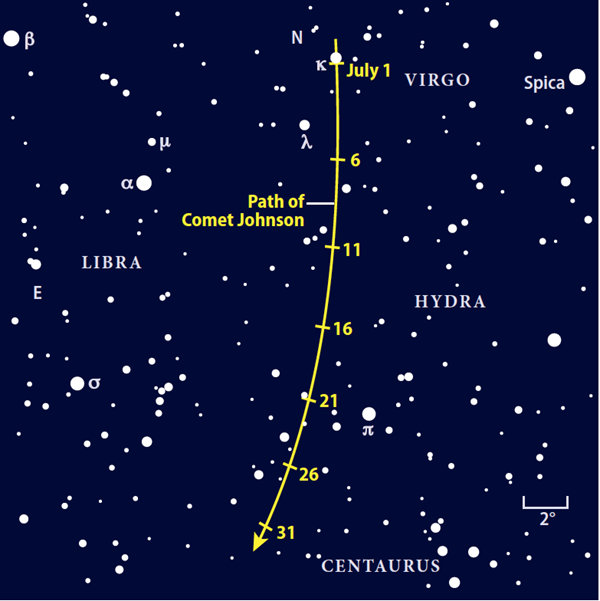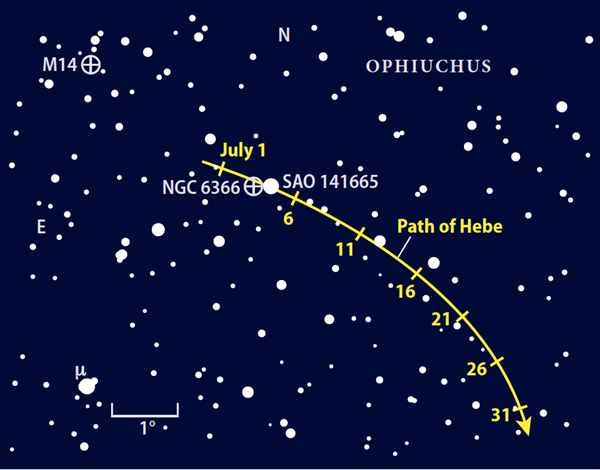But your first target these summer nights should be Mercury. From mid-northern latitudes, this planet hugs the horizon as darkness falls all month. On July 1, it stands 3° high in the west-northwest 30 minutes after sunset. Mercury shines brightly, at magnitude –1.0, which helps it show up against the twilight glow.
The planet’s altitude doubles by the 9th, when it passes through the northern edge of the Beehive star cluster (M44). Unfortunately, twilight renders the cluster nearly invisible unless you have an exceptionally clear sky.
You’ll have an easier time viewing Mercury’s next conjunctions July 24 and 25. The planet then appears 1° from Regulus, Leo the Lion’s brightest star, with the waxing crescent Moon standing watch nearby. On the 24th, the Moon lies 5° to the lower right of the close pair; the following evening, our satellite moves 8° to the duo’s upper left. Mercury shines at magnitude 0.2, a full magnitude brighter than Regulus, and both climb nearly 10° high in the west a half-hour after sundown. A telescope reveals Mercury’s yellow-orange disk, which spans 7″ and appears about half-lit.
Jupiter is the first of the evening’s giant planets to come into view. Shining at magnitude –2.0, it’s a dazzling object in the southwest after sunset. The world lies among the background stars of Virgo northwest of the Maiden’s brightest star, 1st-magnitude Spica. The gap between the two closes from 11° to 8° during July. A gibbous Moon stands nearly 10° to Jupiter’s upper left July 1. On the 28th, our satellite — now a crescent — passes just 3° above Jupiter.
Slew your telescope toward Jupiter for dramatic views of its cloud features and four big moons. But do so in early evening — Jupiter sets by 1 a.m. local daylight time in early July and some two hours earlier by month’s end. As you study the gas giant, bear in mind that the Juno spacecraft is doing the same from its polar orbit.
Also keep an eye out for Jupiter’s four Galilean satellites. Io, Europa, Ganymede, and Callisto (in order of distance from the planet) show up easily through any scope. The moons appear in different positions from night to night, so it often can be difficult to tell them apart. Use “Jupiter’s moons” on p. 41 to differentiate them. Or simply wait until the evening of July 18, when they string out in distance order west of the planet.
The satellites typically appear in a nearly straight line, but that’s not always the case. If you target Jupiter the evening of July 15, you’ll find Callisto due north of the planet. Although all the moons orbit in the same plane, that plane now tilts 3° to our line of sight. This slope means the outermost satellite clears the planet’s disk when the two are in conjunction with each other.
Astroimagers should try to photograph Jupiter on July 31, when it stands 9′ west of the 11th-magnitude spiral galaxy NGC 4941. You’ll need to take multiple exposures to capture the bright planet, its moons, and the faint galaxy. Once you have the exposures right, you’ll be ready to shoot August 1 when Jupiter sits right in front of the galaxy.
As Jupiter dips low in the west, Saturn rides high in the south. The ringed planet shines at magnitude 0.2, far brighter than any of the background stars in Ophiuchus. A nearly Full Moon passes 3° north of Saturn on the evening of July 6. Under darker skies a week later, you’ll be able to see the world nestled among the star-studded fields of the Milky Way.
Saturn always rewards a look through a telescope. The best views come when it lies high in the sky and its light passes through less of Earth’s turbulent atmosphere. It peaks some 30° above the southern horizon around midnight local daylight time July 1; it reaches the same position a half-hour earlier with each passing week.
The Cassini mission to Saturn is now in its dramatic final two months. Since April, the spacecraft has been executing a series of polar orbits that carries it between the giant planet and the C ring. The mission will end in mid-September when the probe makes a fiery plunge into Saturn’s atmosphere.
Although Cassini has made its final close-up observations of Saturn’s large moons, these worlds remain tempting targets through amateur telescopes. Any scope reveals 8th-magnitude Titan, which orbits the planet once every 16 days. It passes due south of Saturn on July 1 and 17 and due north of it on the 9th and 25th.
Tethys, Dione, and Rhea all shine at 10th magnitude and orbit well inside Titan’s leisurely path. You can spot them through a 4-inch scope on most clear nights. Their tighter orbits mean they circle Saturn quite a bit faster than Titan, so they change positions significantly from night to night.
At the other end of the speed scale, distant Iapetus takes 79 days to complete an orbit around the planet and barely budges most nights. Your best chance to spot it comes in the week or so around its July 25 greatest western elongation. Iapetus then shines brightest, at 10th magnitude, because its more-reflective hemisphere faces Earth. You can find the moon 9′ (some 13 ring diameters) west of Saturn.
Our next target lies 25° east of Saturn in Sagittarius the Archer. Pluto reaches opposition and peak visibility the night of July 9/10, but it remains a worthy target through 8-inch and larger instruments all month. For tips and finder charts to help you find this distant world, see “In pursuit of Pluto” on p. 56.
You’ll want to search for Uranus in the hour before twilight starts to paint the sky. It then lies 40° high in the east-southeast among the background stars of Pisces the Fish, just 1° north of magnitude 4.3 Omicron (ο) Piscium. Although you can see the magnitude 5.8 planet with the naked eye under a dark sky, binoculars make the task much easier. When viewed through a telescope, Uranus appears 3.5″ across and distinctly blue-green.
You won’t need any help finding Venus before dawn. The brilliant planet shines at magnitude –4.2 in early July and dims just 0.2 magnitude by month’s end. It rises around 3 a.m. local daylight time and climbs some 20° high in the east an hour before sunup.
You’ll want to follow Venus as it treks eastward against the backdrop of Taurus the Bull. The planet passes 7° south of the Pleiades star cluster (M45) in July’s first few days and then traverses the northern edge of the Hyades cluster at the end of July’s second week. You’ll find it 3° due north of 1st-magnitude Aldebaran, the Bull’s orange-colored luminary, on the 14th.
As Venus continues its march, it meets up with a waning crescent Moon on July 20. The two lie 3° apart and make a spectacular pair in morning twilight. The planet then passes less than 1° south of the Crab Nebula supernova remnant (M1) on the 26th and 0.4° north of 3rd-magnitude Zeta (ζ) Tauri the following morning. Venus spends the final two days of July in the narrow northern sector of Orion.
Unfortunately, Venus’ appearance through a telescope pales in comparison to the view with the naked eye or binoculars. The planet shows a gibbous disk all month that shrinks from 18″ to 15″ in diameter.
Mars is in conjunction with the Sun on July 26 and remains hidden in our star’s glare all month.
| WHEN TO VIEW THE PLANETS | ||
| Evening Sky | Midnight | Morning Sky |
| Mercury (west) | Jupiter (west) | Venus (east) |
| Jupiter (southwest) | Saturn (south) | Uranus (southeast) |
| Saturn (south) | Neptune (east) | Neptune (south) |
Thanks to good timing, this month we can stroll along the western shoreline of Oceanus Procellarum (Ocean of Storms) during the evening hours. This giant “sea” — a lava-filled basin with a surface area somewhat bigger than Earth’s Gulf of Mexico — occupies much of the Moon’s northwestern quadrant. Its western shore often tilts out of view or appears after a midnight moonrise, but this month these highlands show up for a whole week starting at Full Moon the night of July 8/9.
You can get a preview on the evening of the 7th. Look for the prominent horseshoe-shaped crater Eddington near the terminator, the line that divides lunar day from night. First find blazing Aristarchus — the Moon’s brightest feature — and then head west just past Seleucus. Most of the southern half of Eddington’s rim lies buried under a sea of lava.
The evening of July 8 gives us our first view of Einstein west and a little south of Eddington. Einstein appears as a battered ring surrounding a smaller, sharp-rimmed crater. But Einstein won’t look like a typical crater on the 8th because it lies edge-on to our line of sight. Instead, look for three bumps on the limb. This is the crater’s rim and central peak seen in profile. The outer two high spots are a bit farther apart than Eddington’s width.
With each passing night, the Moon’s western limb appears to roll a bit toward us, transforming our view from edge-on to a slightly elevated angle. By July 12, Einstein’s inner crater emerges nicely, surrounded by some of the darker lava that flooded Einstein’s interior.
Meteor observers often view July as a warm-up act for August’s grand Perseid display. But in 2017, the Perseids peak under a waning gibbous Moon, which will drown out most of the fainter meteors and render the brighter ones less impressive.
This year, meteor viewing should be better in late July. The Southern Delta Aquariid shower peaks the morning of July 30, when the First Quarter Moon sets just after midnight local daylight time and leaves the predawn hours free from its unwelcome light. Under a dark sky, observers can expect to see up to 25 meteors per hour, and rates stay above 20 per hour from July 27 to August 1. The best views come from equatorial and Southern Hemisphere sites, where the radiant, which lies in the constellation Aquarius, climbs higher in the sky.
Comet hunters typically seek out dark skies and avoid the Moon like the plague. But July provides an exception in Comet Johnson (C/2015 V2), which should glow at 6th or 7th magnitude in the evening sky and show up quite easily through binoculars or a telescope from the suburbs. And the only time you’ll have to steer clear of the Moon is on the 2nd, when our satellite appears as a waxing gibbous less than 5° north of the comet.
Comet Johnson passed closest to both the Sun and Earth in June, so it should deliver an excellent performance during July. Early in the month, binoculars will show it as a cotton ball some two fields of view to the upper left of 1st-magnitude Spica in Virgo. A 6-inch telescope should reveal a fuzzy ball with both a gas and dust tail flowing to the east. If we’re lucky, the gas tail might glow bright enough to show a subtle green color through 10-inch instruments.
On the evening of July 1, the comet lies just 0.3° south of magnitude 4.2 Kappa (κ) Virginis. It then heads south, passing 2° west of magnitude 4.5 Lambda (λ) Vir on the 4th. It enters Hydra in mid-July and skirts 3° east of magnitude 3.3 Pi (π) Hydrae on the 22nd. It crosses into Centaurus during July’s final week, when it will hang low in the southwest after darkness falls.
If you observe the globular cluster NGC 6366 in Ophiuchus on July 3, you can be forgiven for thinking that one of its stars has gone nova. That evening, asteroid 6 Hebe masquerades as the brightest star on the cluster’s northern fringes. It’s a pity this minor planet moves too slowly for us to see it change position in one night, but you’ll definitely notice it has shifted if you return to the field on the 4th. Hebe then lies on the other side of the cluster and about halfway toward the magnitude 4.5 star SAO 141665.
Located on the Serpent-bearer’s hipbone halfway between Beta (β) and Eta (η) Ophiuchi, SAO 141665 sits in an empty field. If you’ve ever star-hopped to the bright globular M14, you’ve probably stopped at this star along the way. It will be your anchor for finding 9th-magnitude Hebe this month.
The smattering of field stars brighter than this main belt asteroid will help you zero in on it. The evenings of July 12–17 are particularly convenient because Hebe then slides just south of a pair of 6th-magnitude stars. By the end of the month, the asteroid stands nearly alone in front of an uncataloged strip of dark nebulosity.

